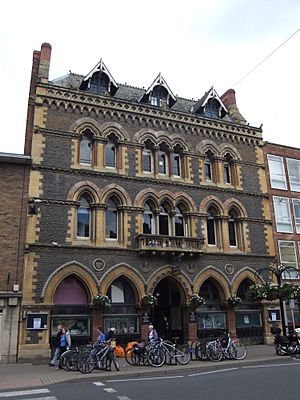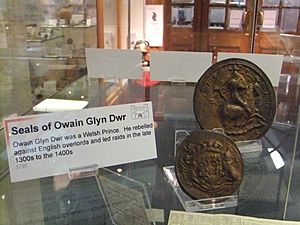Hereford Museum and Art Gallery facts for kids
 |
|
| Lua error in Module:Location_map at line 420: attempt to index field 'wikibase' (a nil value). | |
| Established | 1874 |
|---|---|
| Location | Broad Street, Hereford, Herefordshire, England HR4 9AU |
| Type | Regional museum, art gallery, history museum, decorative arts museum, natural history museum, local museum, archaeological museum |
The Hereford Museum and Art Gallery is a cool place in Hereford, England. It's a museum and art gallery all in one! Here you can explore local history, learn about nature, and see beautiful art. It's a great spot to discover the past and present of Herefordshire.
The museum first opened its doors in 1874. This was made possible by Sir James Rankin MP, who was the head of the Woolhope Naturalists' Field Club. When it first opened, the museum had about 1,000 items on display. Today, the museum is part of the Herefordshire Council's Museum Service. It is currently closed for a big update to make it even better for visitors.
Contents
How the Museum Started
The story of the Hereford Museum and Art Gallery is closely connected to a group called the Woolhope Naturalists' Field Club. This club started in 1851. Its goal was to study the natural world of Herefordshire and the areas nearby. The club got its name from the Woolhope Dome, which is an area of old rocks near the village of Woolhope.
In 1869, Sir James Rankin, who was the club's president, offered money to build a library and museum. This idea was approved in 1870. A special committee was formed with members from the Woolhope Club and the Town Council. They decided to accept Sir James Rankin's offer. He provided the money to buy land on Broad Street in the center of Hereford. The land cost £1,750.
The first stone for the building was laid in March 1873. The museum and library officially opened on October 8, 1874.
The Museum Building
The Hereford Times newspaper once called the Library and Museum building "truly an ornament of the city." This means they thought it was a beautiful addition to Hereford. A local architect named Frederick Roberston Kempson designed the building. He was a member of the FRIBA.
His design was inspired by a style called Venetian Gothic revival. You can see this in its unique front, which has detailed carvings of animals, plants, and signs of the zodiac. The building cost £7,600 to build. Sir James Rankin gave £6,115, and the City Council raised the rest of the money.
When it first opened, the ground floor had two rooms facing Broad Street. These were meant to be reading rooms, but they had to be rented out as shops. This helped raise money for museum display cases. At the back was a large, tall library. The museum and the Woolhope Club Room were on the second floor. The third and fourth floors were living spaces for the librarian or curator.
Later, the building was made even bigger. This happened thanks to gifts from Sir Joseph Pulley MP and his nephew, Sir Charles Pulley MP. The new part opened on April 12, 1912. It added a new library on the ground floor and an art gallery on the second floor. The museum was connected to the new art gallery by beautiful oak doors. The first art show in April 1912 displayed local artworks borrowed from private collections.
The building got its first update in 1900 when electric lights were put in. Before that, gas lights were used. In 1963, an extra floor was added above the library, making it twice as big. The building was recognized as a special historical site on October 22, 1973. It closed for a short time in 2015 to remove asbestos and reopened in 2017. Because of some building issues and fire rules, only ten people could visit at a time after 2020. The museum closed on July 18, 2023, for a complete makeover.
What Was on Display
When the museum first opened in 1874, it didn't have any display cases. Money for these cases was raised by renting out the ground-floor rooms. By 1875, enough money was collected to buy them.
Members of the Woolhope Club and other local groups were asked to give items to the museum. Their generous donations became the start of the Herefordshire Museum Service's collections. In 1927, money was raised from the public to put two Roman floor mosaics from Kenchester in the stair hall. The museum's collections grew even more with the help of curators like Mr. F.C. Morgan.
Recent Museum Exhibits
The museum's displays stayed mostly the same from 1960 until the year 2000. This was because everyone expected the building to be updated and the library to move to a new home.
New hands-on exhibits were created with the Royal National College for the Blind. In 2005, the museum was the first in the United Kingdom to use the Talking Tactile Tablet (T3). This special tablet was developed at the Royal National College for the Blind.
Over the next 20 years, the exhibits were often changed and updated. Before closing for its big update in 2023, the museum had many interesting things. These included a two-headed calf, a two-meter-long fish, and various swords. There were also costumes, textiles, and items from prehistoric times up to the 20th century. During summer, a bee colony even lived there! A special part of the art gallery showed works by Brian Hatton, including some of his art supplies and letters.
Special Exhibitions

The art gallery often showed temporary exhibitions. These featured craftwork, paintings, photography, and prints.
In 2006, the museum celebrated the 200th birthday of Joseph Murray Ince with an exhibition. The designs of Christopher Dresser were shown in 2007.
From August to October 2020, an exhibition called "The Ice Age in Herefordshire" explored local landscapes. This was made possible with funding from the National Lottery. The main attraction was a life-sized model of a Woolly Mammoth.
The art gallery also hosted an exhibition by Grayson Perry called "The Vanity of Small Differences." This show ran from October to December 2021. It featured six tapestries that told a story about social class and how it affects people's tastes.
Exciting Redevelopment Plans
In July 2023, the National Lottery Heritage Fund announced a £5 million award for the museum's redevelopment. Herefordshire Council added £8 million, and the Stronger Towns Fund gave £5 million.
The plans for the museum are very exciting! They include:
- New galleries and display areas.
- A special space for temporary exhibitions.
- Restoring the old Woolhope Club Room.
- New areas for shops and a rooftop café.
- A brand new floor with a viewing beacon and roof terrace. This will offer amazing 360-degree views of the city and the beautiful Herefordshire countryside.
See also

